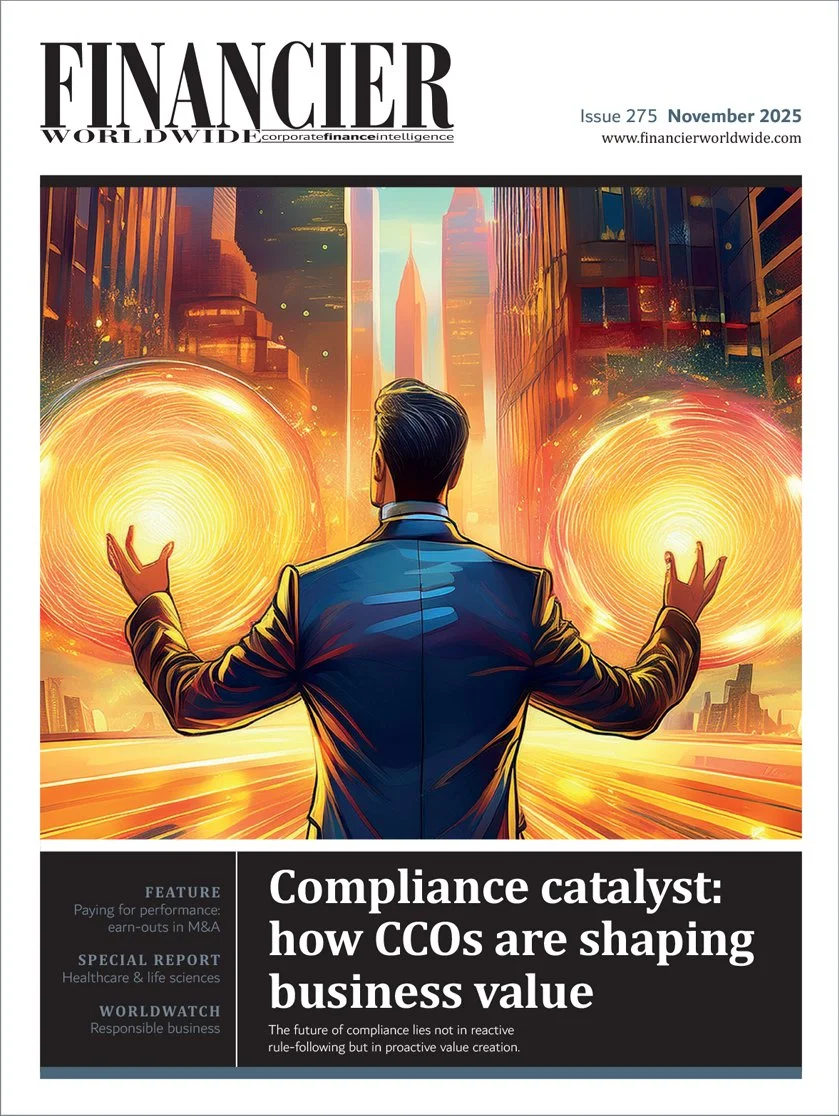Paying for performance: earn-outs in M&A
November 2025 | FEATURE | MERGERS & ACQUISITIONS
Financier Worldwide Magazine
While always the primary driver of a business transaction, the pressure to achieve optimal value is becoming increasingly burdensome for dealmakers, particularly amid the intertwined challenges of the current global environment.
In the world of M&A, one key method of maximising transactional value is through a mechanism known as an earn-out – a deal term that is often as crucial as it is contentious.
As defined by the Corporate Finance Institute, an earn-out is a risk allocation mechanism for the acquirer, wherein the purchase price is contingent on the future performance of the target company. The acquirer pays the majority of the purchase price upfront, at the time of closing, with the remainder dependent on the target’s subsequent performance.
For example, if the seller believes the business is worth $100m and the acquirer values it at $70m, they may agree on an initial price of $70m, with the remaining $30m forming part of the earn-out. This contingent amount may depend on factors such as revenue, earnings before interest, taxes, depreciation and amortisation (EBITDA) margins, earnings per share, or the retention of key employees.
Increasingly used in today’s unpredictable business climate, earn-outs are typically employed in full buyouts where the owner remains involved in the business for a period following the transaction. Among the most active users of this mechanism are private equity-backed serial acquirers or those executing consolidation strategies.
“Earn-outs are gaining traction as a practical solution to bridge valuation gaps in today’s volatile M&A environment,” concurs Frank Aquila, a partner at Sullivan & Cromwell LLP. “In 2023, they featured in 26 percent of private deals – up 30 percent from the prior year – highlighting their growing significance.”
The mechanism is also increasingly common in early-stage companies, businesses undergoing turnaround efforts, or sectors experiencing rapid disruption, such as technology. Earn-outs are frequently used by buyers seeking to retain individual sellers within the target business, serving as a tool to incentivise and align interests post-transaction.
“Sellers see earn-outs as a means to capture full value potential, while buyers use them to de-risk their investment,” notes Mr Aquila. “They are particularly useful when price expectations diverge, but both sides are willing to transact if performance justifies the upside.”
Despite their perceived simplicity and the value they purport to add, earn-outs can be complex, particularly in relation to the clauses that govern them. These clauses often contain detailed provisions that require significant expertise to navigate.
Structuring an earn-out
Once the decision to use an earn-out has been made, the next step is to agree its structure, which will vary considerably from deal to deal.
Slaughter and May, in its report ‘A Bridge Over Troubled Water: Key Tips and Traps for Earn-outs in International M&A’, highlights several key considerations when establishing the terms of an earn-out arrangement.
“With the cost of capital contributing to an increasingly uncertain market, earn-outs remain a vital mechanism for bridging valuation gaps – an essential tool in the deal structuring playbook.”
The central component is the performance metric – financial or non-financial – that determines whether the earn-out is payable. Parties may customise metrics to suit the business in question, tying them to the performance of a specific division, product or geography. Earn-outs may be structured as all-or-nothing, where payment is made only if a defined target is achieved.
“Principals need to be very clear on what the performance metric is – for example, revenue target or EBITDA – for the triggering payment of the earn-out,” advises Gee Lam, a partner at KPMG in the UK. “They must also establish the accounting basis for measuring the financial metric and how disputes will be resolved.”
The parties must also agree on the duration of the earn-out period. This will be influenced by the type of performance metric used and any business plan underpinning the earn-out calculation. The period should be long enough to account for acquisition-related disruption and expected fluctuations in performance.
“The measuring period should be as short as possible, ideally one or two years from legal closing,” adds Mr Lam. “Parties should align on the objective of the earn-out so that it can be designed around their own objectives. This way, the earn-out can be a useful and fair tool to bridge any valuation gap.”
Adjustments may be agreed to exclude extraordinary or one-off items that do not reflect the normal profits of the business. Accurate accounting is essential to ensure these adjustments are framed appropriately.
Contingent value rights (CVRs)
While earn-outs are often associated with private M&A transactions, they are also used in public company acquisitions, where traditional post-closing contingent payments may be more difficult to administer.
“Public company acquirers use CVRs as a functional equivalent to conventional earn-outs in private acquisitions,” explains Mr Aquila. “A CVR is a security issued to target shareholders that entitles them to additional consideration if certain post-closing milestones are met – typically tied to performance, regulatory outcomes or asset sales.
“CVRs are contractual in nature but can be registered and tradeable, enabling broader shareholder participation. Importantly, CVRs are structured to comply with securities regulations and allow for continued market-based pricing transparency,” he adds.
Although complex to design and administer, CVRs can effectively bridge valuation gaps in strategic public transactions – particularly in the pharmaceutical and biotech sectors, where outcomes may be binary or long-dated. Robust disclosure, independent oversight and clear payout mechanics are essential to their success.
Beyond their financial function, CVRs act as a market signal, reflecting the acquirer’s confidence in the target’s long-term potential. This is especially valuable in sectors with extended innovation cycles and regulatory sensitivity. By linking future payments to defined milestones, CVRs offer transparency and flexibility, reassuring shareholders while accommodating uncertainty. Their design can also capture strategic achievements beyond financial metrics, such as clinical trial success or environmental certification, making them particularly relevant in industries where intangible progress drives value.
As public markets increasingly prioritise environmental, social and governance factors, CVRs may evolve to include sustainability-linked triggers. This shift could align financial incentives with broader corporate responsibility goals, positioning CVRs not only as deal tools but as instruments of strategic alignment. Their adaptability and signalling power make CVRs a compelling option in public M&A, especially where future value is difficult to quantify at the point of acquisition.
Downsides
Despite their appeal, earn-outs can lead to disputes between parties, ranging from misinterpretation of target metrics to disagreements over post-closing performance measurement.
Aventis Advisors, in its analysis ‘M&A Earnouts Explained: The Win-Win Strategy for M&A Deals’, highlights several common issues, including control limitations, disagreements, external factors and deal complexity.
Sellers may experience reduced control over operations during the earn-out period, which can be frustrating for founders accustomed to autonomy. This may lead to conflicting priorities, with sellers focusing on short-term targets rather than long-term value creation.
“Earn-outs can sometimes create conflicting priorities, leading sellers to focus on hitting short-term targets rather than building long term business value,” says Mark Williams, global chief revenue officer at Datasite. “Problems can arise when sellers maintain operational control while buyers cannot make necessary business changes that might impact earn-out payments.”
Disputes are common when earn-out agreements contain ambiguities. “Deferred consideration is sometimes referred to as deferred disputes,” concurs Mr Lam. “This is because the negotiation and drafting of earn-outs can be complicated, as principals are locking down the basis of something that will be measured in the future.”
External factors such as economic downturns or industry disruptions may affect business performance and the ability to meet earn-out targets.
Moreover, earn-outs add complexity to the deal, requiring extensive negotiation and legal input to craft a mutually beneficial structure. “Ambitious or overly complex targets in respect of the earn-out metric can drive adverse behaviours,” affirms Mr Lam. “To avoid deadlocks, be sure to include dispute resolution mechanisms, such as independent expert determination.”
Another risk, as noted by Filip Drazdou, M&A director at Aventis Advisors, is that sellers may lose motivation if they believe the earn-out is unachievable. “To address this, a tiered earn-out structure with multiple performance brackets can be used,” he suggests.
Balancing risk and reward
To ensure an earn-out structure effectively bridges valuation gaps, it must be tailored to the specific features of the transaction – balancing risk and reward for both parties.
“Clear rules for the earn-out should be established at the letter of intent stage to avoid surprises later in the process,” asserts Mr Drazdou. “Ensure that both parties fully understand the earn-out principles and the incentives for both the buyer and the seller under the proposed structure.”
According to Aventis Advisors, buyers should define key performance indicators and metrics following due diligence and incorporate them into the share purchase agreement. A clause should specify the maximum earn-out amount payable to the seller. Involving the seller in goal-setting can foster collaboration and alignment. The ultimate aim is to create a structure that benefits all parties and supports long-term value creation.
Sellers should ensure that unforeseen events outside their control, such as economic or industry changes, are considered in earn-out calculations. Provisions should protect against externalities that may affect performance. Negotiating a guaranteed minimum earn-out amount can provide baseline compensation. Establishing clear communication and a robust dispute resolution framework is essential.
“It is important to establish trust between the buyer and the seller,” adds Mr Drazdou. “Ultimately, trust is the most important factor. If there is trust between the buyer and seller, negotiations are straightforward. However, if trust is lacking and each party believes the other is acting in bad faith, even the best-structured earn-out will be ineffective.”
Earn-out evolution
With the cost of capital contributing to an increasingly uncertain market, earn-outs remain a vital mechanism for bridging valuation gaps – an essential tool in the deal structuring playbook.
“As uncertainty persists, earn-outs are likely to become even more prevalent, especially in sectors with volatile revenues, rapid innovation cycles or complex growth trajectories,” agrees Mr Aquila. “This may be particularly true for businesses where it is difficult to fully understand the impact of tariffs on future performance. In these situations, earn-outs offer a pragmatic way to bridge valuation gaps without killing deals.”
As earn-outs become more widespread, Mr Williams suggests that traditional valuation methods may no longer be suitable for emerging business models. “Artificial intelligence and data analytics will enable better performance tracking and more sophisticated measurement criteria,” he says. “Economic uncertainty, regulatory changes and sector specific disruptions will all shape how earn-outs are used and structured.”
As M&A deals grow in complexity, earn-outs are evolving into strategic tools that reflect deeper alignment between parties. More than financial mechanisms, they foster shared vision and long-term commitment. In uncertain markets, earn-outs offer a pragmatic way to navigate valuation ambiguity, encouraging collaborative forecasting rather than adversarial negotiation. Their true value lies in building trust and adaptability. As technology transforms performance tracking and global conditions remain volatile, earn-outs will continue to shift from rigid formulas to flexible thinking – not just bridging valuation gaps, but reshaping how dealmakers approach growth, integration and the future of transactional strategy.
© Financier Worldwide
BY
Fraser Tennant


